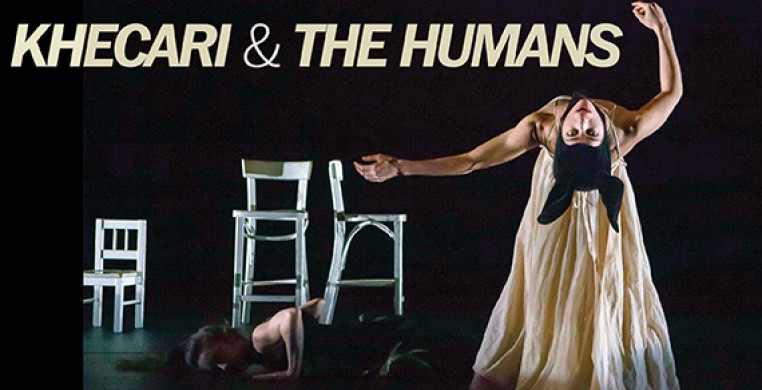Something felt amiss at the Dance Center of Columbia College during the opening performance of a double-billed Khecari and The Humans program. The New Stages for Dance grant that brought the two dance companies to the Dance Center intends to open the door for small budget companies to present work at larger venues, to a broader audience. In theory, that sounds great, and indeed the house at 1306 S. Michigan was nearly full on opening night. We are accustomed to seeing the works of Khecari (Julia Rae Antonick and Jonathan Meyer) and The Humans (Rachel Bunting) in intimate Park District ballrooms, and the formality and separatism of a large proscenium stage sometimes felt not quite right for the three works presented.
Antonick’s "Cresset: Vibrant, rusting" first premiered in her home space at Revere Park. The opportunity to create an immersive experience is never lost in Antonick’s work, and the messy, earth-toned piece on the topic of decay once set in a corroding, ornate ballroom is now presented as a more refined and polished product, to its detriment. Cool-colored lights cast down pools on the dancers faces that placed Antonick’s elaborate hair and makeup choices in shadows. The once knock-your-socks-off powerful performances of Maggie Koller, Jordan Reinwald, Danielle Hammer and Chih-Hsien Lin were muted by "Cresset’s" dark and massive new home. Had one not seen the original, the stripped down version might not feel so bare, and the work most resembled itself in a moment of slow-motion undulations downstage from Reinwald and Hammer. In particular, Reinwald’s faces conveying a grotesque dry heave of disgust, plus enough light to see the whites of her wide open stare and glittered long lashes are the salient moments of the work.
While Antonick’s work felt a stranger to the Dance Center stage, Meyer’s "Esther & the Omphali" appeared to be at home in the big, beefy space. Elaborate sequences of light cast fleeting shadows on the bare back wall; the technical chutzpah of the venue allowed Meyer to try things that wouldn’t be possible at his usual haunts. Dancers Josh Anderson and Edson Cabrera demonstrate an ability to thrive in the weird worlds Khecari creates, and also to flat out dance. The exhausting duet is a masculine display of capoeria-like athleticism accompanied live by Sarah Morgan’s haunting accordion score. As Morgan plays the end serenade, the two men embark on a slow-motion wrestling match that feels oddly tender, intimate, and beautiful.
Rachel Bunting’s "My My Gray Sky" is described as “a fantastical odyssey with thirteen performers spanning ages from seven to sixty.” An odyssey indeed, what should be an evening length concert came after Khecari’s hour-long contribution. Some truly impactful moments occur toward the beginning: ten dancers in Collin Bunting’s stunning, genderless tree dresses dance a powerful unison conducted by a little girl downstage (Vera Brenneman). Haunting, powerful, and exquisitely executed, this section is followed by an equally powerful additive phrase in which dancers poke and prod themselves with feather quills. As Bunting emerges onstage in a plush black bunny cap, a ridiculous (in a good way) dance unfolds to a vintage tune. And it should have ended there. In an already long concert, the second half of my my gray sky was a different sort of ridiculous, with bacci balls, tap dancing, video, fur pelts, gestures, masks, chairs, scrim pulls, and Matthew McMunn in a deer mask and a dance belt thrown around willy-nilly… none of which were fully realized. The once important role of Brenneman as the conductor of the ensemble degrades into nothing more than a cute distraction as the work wears on. Maybe all this wouldn’t matter had the first half of the piece not been so strongly structured and executed.


